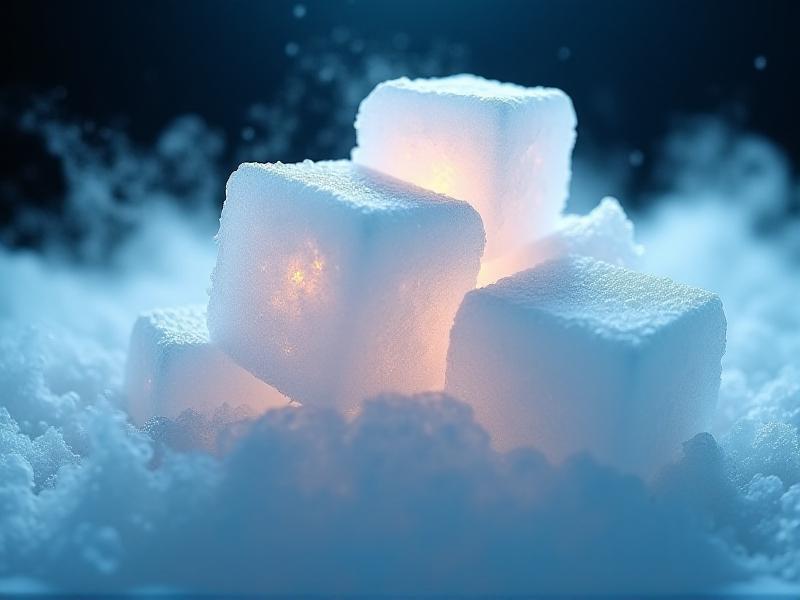Disposal Guidelines for Spent Dry Ice
Understanding Dry Ice: What It Is and Why Proper Disposal Matters
Dry ice, the solid form of carbon dioxide (CO2), is widely used for cooling, freezing, and creating special effects. Unlike regular ice, it sublimates directly from a solid to a gas, leaving no liquid residue. While this property makes it incredibly useful, it also poses unique challenges when it comes to disposal. Improper handling of dry ice can lead to safety hazards, including frostbite, asphyxiation, and even explosions in confined spaces. Understanding the nature of dry ice is the first step toward ensuring its safe and responsible disposal.

Dry ice is commonly used in industries such as food preservation, medical transportation, and entertainment. Its extreme cold temperature of -78.5°C (-109.3°F) makes it ideal for keeping perishable items frozen during transit. However, this same property requires careful handling to avoid injury. Additionally, the sublimation process releases CO2 gas, which can displace oxygen in poorly ventilated areas, posing a risk to human health. Proper disposal methods are essential to mitigate these risks and ensure environmental safety.
Safety Precautions for Handling Spent Dry Ice
Before disposing of dry ice, it’s crucial to take necessary safety precautions. Always wear insulated gloves and protective eyewear to prevent frostbite or eye injuries. Avoid direct skin contact, as the extreme cold can cause severe burns. Additionally, handle dry ice in well-ventilated areas to prevent the buildup of CO2 gas, which can lead to dizziness, headaches, or even unconsciousness. Keep dry ice away from children and pets, and never store it in airtight containers, as the pressure from sublimating gas can cause explosions.

When transporting dry ice, use insulated containers designed for this purpose. These containers allow the gas to escape while maintaining the cold temperature. Avoid placing dry ice in freezers or refrigerators, as the extreme cold can damage the appliance and cause it to malfunction. By following these safety measures, you can minimize the risks associated with handling and disposing of dry ice, ensuring a safe environment for yourself and others.
Step-by-Step Guide to Disposing of Spent Dry Ice
Disposing of dry ice requires a systematic approach to ensure safety and environmental responsibility. Start by allowing the dry ice to sublimate in a well-ventilated area. Place it on a flat, stable surface away from direct sunlight, as heat can accelerate the sublimation process. If you need to speed up the process, you can break the dry ice into smaller pieces using a hammer or mallet, but always wear protective gear to avoid injury.

Once the dry ice has completely sublimated, ensure the area is well-ventilated to disperse any remaining CO2 gas. If you’re disposing of a large quantity of dry ice, consider doing so in an open outdoor space to prevent gas buildup. Never dispose of dry ice in sinks, toilets, or drains, as the extreme cold can damage plumbing systems. By following these steps, you can safely and effectively dispose of dry ice without harming yourself or the environment.
Environmental Impact of Improper Dry Ice Disposal
Improper disposal of dry ice can have significant environmental consequences. When dry ice sublimates, it releases CO2 gas, a greenhouse gas that contributes to global warming. While the amount of CO2 released from dry ice is relatively small compared to industrial emissions, every effort to minimize its impact is essential. Additionally, disposing of dry ice in water bodies or drains can harm aquatic life and disrupt ecosystems due to the sudden drop in temperature and the release of CO2 gas.
To reduce the environmental impact of dry ice disposal, consider using alternative cooling methods whenever possible. For example, reusable gel packs or insulated containers can be effective substitutes for dry ice in some applications. When dry ice is necessary, ensure it is disposed of responsibly, following the guidelines outlined in this article. By taking these steps, you can contribute to a healthier planet while still benefiting from the unique properties of dry ice.
Common Mistakes to Avoid When Disposing of Dry Ice
Many people make mistakes when disposing of dry ice, often due to a lack of understanding of its properties. One common error is placing dry ice in airtight containers, which can lead to pressure buildup and potential explosions. Another mistake is disposing of dry ice in sinks or drains, where the extreme cold can cause pipes to crack or burst. Additionally, some people underestimate the risks of CO2 gas buildup, leading to unsafe conditions in poorly ventilated areas.
To avoid these mistakes, always follow proper disposal guidelines and educate yourself on the unique properties of dry ice. Use insulated containers designed for dry ice, and never store it in sealed environments. Dispose of dry ice in well-ventilated areas, and avoid placing it in water or plumbing systems. By being aware of these common pitfalls, you can ensure the safe and effective disposal of dry ice, protecting both yourself and the environment.
Innovative Uses for Spent Dry Ice Beyond Disposal
While disposal is a critical aspect of handling dry ice, there are also innovative ways to repurpose it before it fully sublimates. For example, dry ice can be used to create fog effects for theatrical performances or Halloween decorations. It can also be used in science experiments to demonstrate sublimation or to create carbon dioxide-rich environments for plant growth studies. Additionally, dry ice can be used to clean surfaces by blasting away dirt and debris in a process known as dry ice blasting.
These creative applications not only extend the usefulness of dry ice but also reduce waste by delaying its disposal. However, it’s essential to handle dry ice safely even when repurposing it, as the risks of frostbite and CO2 exposure remain. By exploring these innovative uses, you can make the most of dry ice while minimizing its environmental impact and ensuring safe handling practices.
Legal and Regulatory Considerations for Dry Ice Disposal
Disposing of dry ice is not just a matter of safety and environmental responsibility—it’s also subject to legal and regulatory considerations. In many regions, dry ice is classified as a hazardous material due to its extreme cold and the CO2 gas it releases. As such, businesses and individuals must comply with local regulations governing its transportation, storage, and disposal. Failure to adhere to these regulations can result in fines, legal action, or even harm to public health and safety.
To ensure compliance, familiarize yourself with the laws and regulations in your area. This may include obtaining permits for transporting large quantities of dry ice, using approved containers, and following specific disposal protocols. Businesses that use dry ice regularly should also train employees on proper handling and disposal procedures to avoid legal issues and maintain a safe workplace. By staying informed and compliant, you can responsibly manage dry ice disposal while adhering to legal standards.
Conclusion: The Importance of Responsible Dry Ice Disposal
Proper disposal of dry ice is essential for ensuring safety, protecting the environment, and complying with legal regulations. By understanding the unique properties of dry ice, taking necessary safety precautions, and following step-by-step disposal guidelines, you can minimize risks and contribute to a healthier planet. Additionally, exploring innovative uses for dry ice and staying informed about legal considerations can further enhance your ability to manage this versatile material responsibly.
Whether you’re using dry ice for cooling, special effects, or scientific experiments, always prioritize safety and environmental responsibility. By doing so, you can enjoy the benefits of dry ice while ensuring its impact on the world is as minimal as possible. Remember, responsible disposal is not just a best practice—it’s a commitment to the well-being of our planet and future generations.








